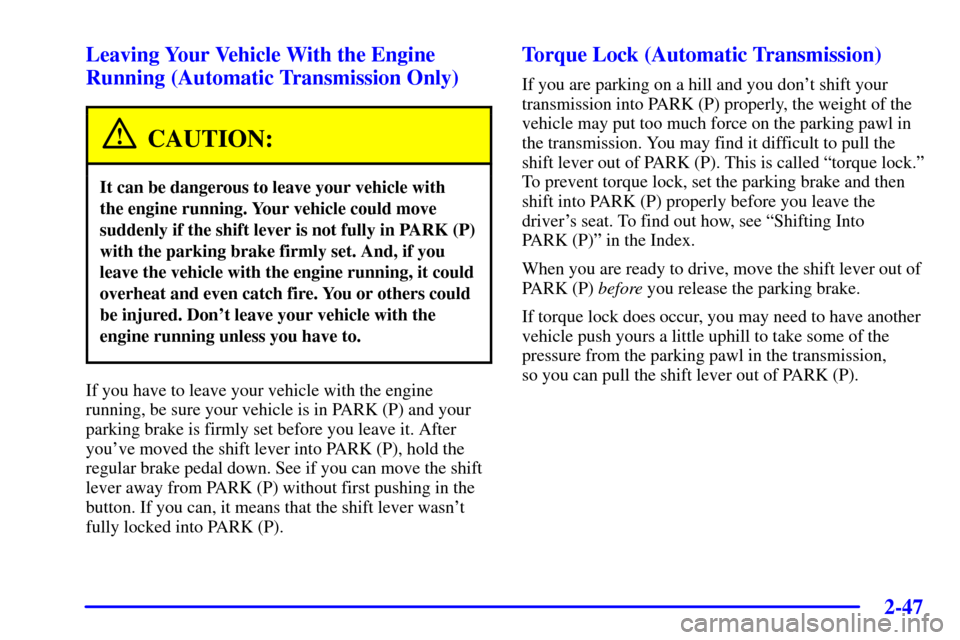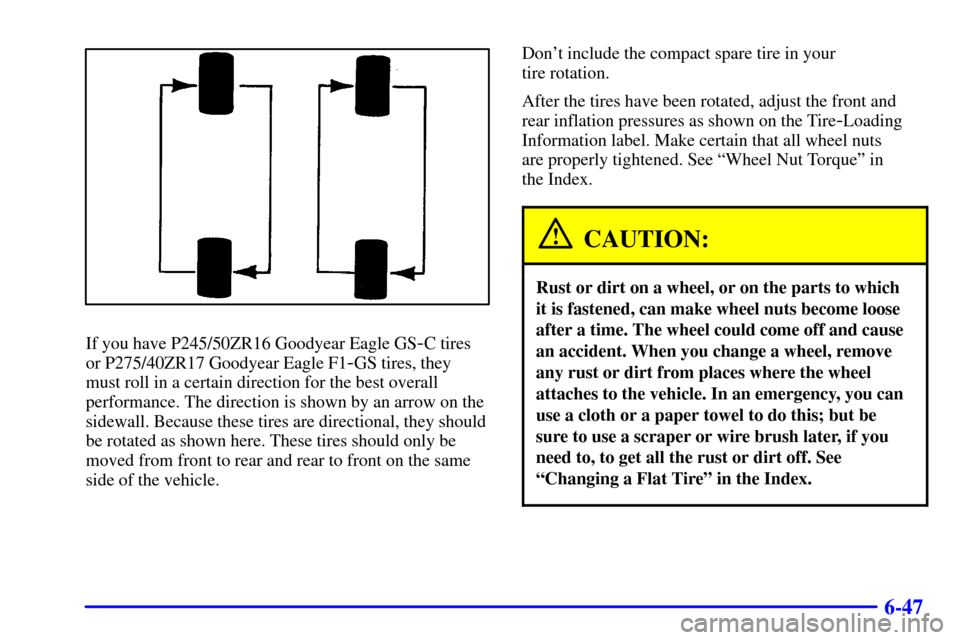Page 91 of 356

2-38
AUTOMATIC OVERDRIVE (�): This position is
for normal driving. If you need more power for passing,
and you're:
�Going less than about 35 mph (55 km/h), push your
accelerator pedal about halfway down.
�Going about 35 mph (55 km/h) or more, push the
accelerator all the way down.
You'll shift down to the next gear and have more power.
DRIVE (D): This position is also used for normal
driving, however, it offers more power and lower fuel
economy than AUTOMATIC OVERDRIVE (�).
Here are some times you might choose DRIVE (D)
instead of AUTOMATIC OVERDRIVE (�):
�When driving on hilly, winding roads.
�When towing a trailer, so there is less shifting
between gears.
�When going down a steep hill.SECOND (2): This position gives you more power but
lower fuel economy. You can use SECOND (2) on hills.
It can help control your speed as you go down steep
mountain roads, but then you would also want to use
your brakes off and on.
If you have a 5.7L V8 engine and manually
select SECOND (2) when you start the vehicle,
the transmission will drive (and stay) in second gear.
You may use this feature for reducing torque to the
rear wheels when you are trying to start your vehicle
from a stop on slippery road surfaces, or for preventing
the transmission from downshifting into FIRST (1) in
situations where a downshift would be undesirable.
NOTICE:
Don't drive in SECOND (2) for more than
25 miles (40 km), or at speeds over 55 mph
(90 km/h), or you can damage your transmission.
Use AUTOMATIC OVERDRIVE (�) or
DRIVE (D) as much as possible.
Don't shift into SECOND (2) unless you are going
slower than 65 mph (105 km/h), or you can
damage your engine.
Page 100 of 356

2-47
Leaving Your Vehicle With the Engine
Running (Automatic Transmission Only)
CAUTION:
It can be dangerous to leave your vehicle with
the engine running. Your vehicle could move
suddenly if the shift lever is not fully in PARK (P)
with the parking brake firmly set. And, if you
leave the vehicle with the engine running, it could
overheat and even catch fire. You or others could
be injured. Don't leave your vehicle with the
engine running unless you have to.
If you have to leave your vehicle with the engine
running, be sure your vehicle is in PARK (P) and your
parking brake is firmly set before you leave it. After
you've moved the shift lever into PARK (P), hold the
regular brake pedal down. See if you can move the shift
lever away from PARK (P) without first pushing in the
button. If you can, it means that the shift lever wasn't
fully locked into PARK (P).
Torque Lock (Automatic Transmission)
If you are parking on a hill and you don't shift your
transmission into PARK (P) properly, the weight of the
vehicle may put too much force on the parking pawl in
the transmission. You may find it difficult to pull the
shift lever out of PARK (P). This is called ªtorque lock.º
To prevent torque lock, set the parking brake and then
shift into PARK (P) properly before you leave the
driver's seat. To find out how, see ªShifting Into
PARK (P)º in the Index.
When you are ready to drive, move the shift lever out of
PARK (P) before you release the parking brake.
If torque lock does occur, you may need to have another
vehicle push yours a little uphill to take some of the
pressure from the parking pawl in the transmission,
so you can pull the shift lever out of PARK (P).
Page 242 of 356
5-32
8. Tighten the wheel nuts
firmly in a crisscross
sequence as shown.
Install the plastic nut caps and tighten by hand.
Then, using the wheel wrench, tighten an additional
one
-quarter turn.
CAUTION:
Incorrect wheel nuts or improperly tightened
wheel nuts can cause the wheel to become loose
and even come off. This could lead to an accident.
Be sure to use the correct wheel nuts. If you have
to replace them, be sure to get new GM original
equipment wheel nuts.
Stop somewhere as soon as you can and have
the nuts tightened with a torque wrench to
100 lb
-ft (140 N´m).
Page 243 of 356
5-33
NOTICE:
Improperly tightened wheel nuts can lead to
brake pulsation and rotor damage. To avoid
expensive brake repairs, evenly tighten the
wheel nuts in the proper sequence and to the
proper torque specification.
Storing a Flat or Spare Tire and Tools
CAUTION:
Storing a jack, a tire or other equipment in the
passenger compartment of the vehicle could
cause injury. In a sudden stop or collision, loose
equipment could strike someone. Store all these
in the proper place.
Put back the jack, wheel wrench and flat tire following
the storage instructions. When you reinstall the trim
panel, be sure to tuck it under the weatherstrip.
Page 293 of 356

6-47
If you have P245/50ZR16 Goodyear Eagle GS-C tires
or P275/40ZR17 Goodyear Eagle F1
-GS tires, they
must roll in a certain direction for the best overall
performance. The direction is shown by an arrow on the
sidewall. Because these tires are directional, they should
be rotated as shown here. These tires should only be
moved from front to rear and rear to front on the same
side of the vehicle.Don't include the compact spare tire in your
tire rotation.
After the tires have been rotated, adjust the front and
rear inflation pressures as shown on the Tire
-Loading
Information label. Make certain that all wheel nuts
are properly tightened. See ªWheel Nut Torqueº in
the Index.
CAUTION:
Rust or dirt on a wheel, or on the parts to which
it is fastened, can make wheel nuts become loose
after a time. The wheel could come off and cause
an accident. When you change a wheel, remove
any rust or dirt from places where the wheel
attaches to the vehicle. In an emergency, you can
use a cloth or a paper towel to do this; but be
sure to use a scraper or wire brush later, if you
need to, to get all the rust or dirt off. See
ªChanging a Flat Tireº in the Index.
Page 317 of 356

6-71
Capacities and Specifications
The following approximate capacities are given in
English and metric conversions. Please refer to
ªRecommended Fluids and Lubricantsº in the Index
for more information.
Automatic Transmission
Drain and Refill Overhaul 5.0 quarts (4.7 L). . . . . .
3800 V6 8.8 quarts (8.3 L). . . . . . . . . . . . . . . . . . . .
5.7L V8 10.8 quarts (10.2 L). . . . . . . . . . . . . . . . . .
Manual Transmission
Five
-Speed 3.4 quarts (3.2 L). . . . . . . . . . . . . . . . .
Six
-Speed 4.0 quarts (3.8 L). . . . . . . . . . . . . . . . . . Cooling System
3800 V6
With Manual Transmission 11.6 quarts (11.0 L). . . .
With Automatic Transmission 11.4 quarts (10.8 L). .
5.7L V8
With Manual Transmission 11.9 quarts (11.3 L). . . .
With Automatic Transmission 11.8 quarts (11.2 L).
Engine Oil with Filter
3800 V6 4.5 quarts (4.2 L). . . . . . . . . . . . . . . . . . . .
5.7L V8 5.5 quarts (5.2 L). . . . . . . . . . . . . . . . . . . .
Fuel Tank16.8 U.S. gallons (63 L) . . . . . . . . . . . . . .
Wheel Nut Torque100 lb-ft (140 N´m) . . . . . . . . . .
All capacities are approximate. When adding, be sure to
fill to the approximate level, as recommended in this
manual. Recheck fluid level after filling.
Engine Specifications
Type
VIN Engine Code K 3800 V6. . . . . . . . . . . . . . . . . . .
VIN Engine Code G 5.7L V8. . . . . . . . . . . . . . . . . . . .